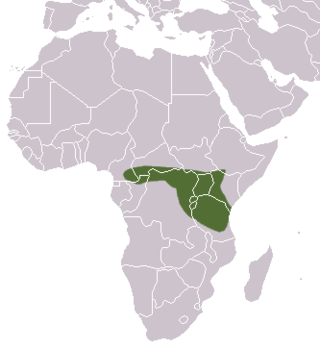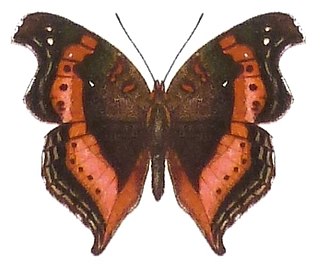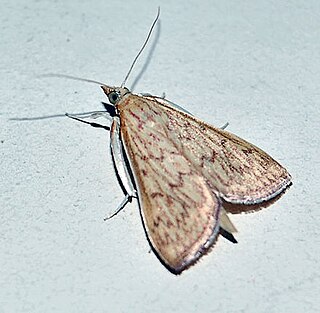
Hildegarde's shrew is a species of mammal in the family Soricidae. It is found in Burundi, Cameroon, Central African Republic, Republic of the Congo, Democratic Republic of the Congo, Ethiopia, Kenya, Rwanda, and Tanzania. Considered by some authorities to be a subspecies of Crocidura gracilipes, it is now recognised as a separate species, with a diploid chromosome number of 2n = 52. This is one of three species of small mammal named by the British zoologist Oldfield Thomas in honour of anthropologist Hildegarde Beatrice Hinde.
Atrotus is a genus in the beetle family Carabidae. There are about 18 described species in Atrotus.

Mylothris sjostedti, Sjoestedt's dotted border, is a butterfly in the family Pieridae. It is found in Nigeria, Cameroon, the Democratic Republic of the Congo, Uganda, Burundi and Tanzania. The habitat consists of forests. The name honours Bror Yngve Sjöstedt.

Euxanthe crossleyi, the Crossley's forest queen, is a butterfly in the family Nymphalidae. It is found in Nigeria, Cameroon, Gabon, the Republic of the Congo, the Central African Republic, the Democratic Republic of the Congo, Zambia, Sudan, Uganda, Rwanda, Burundi, Kenya and Tanzania. The habitat consists of lowland evergreen forest and riverine forests.

Precis sinuata, the wide-banded commodore, is a butterfly in the family Nymphalidae. It is found in Guinea, Sierra Leone, Liberia, Ivory Coast, Ghana, Nigeria, Cameroon, Equatorial Guinea, São Tomé and Príncipe, the Republic of the Congo, the Central African Republic, the Democratic Republic of the Congo, Uganda, Rwanda, Burundi, Kenya, Tanzania, Malawi, Zambia and Mozambique. The habitat consists of forests and woodland.

Neptis agouale, the common club-dot sailer , is a butterfly in the family Nymphalidae. It is found in Senegal, Guinea-Bissau, Sierra Leone, Liberia, Ivory Coast, Ghana, Togo, Nigeria, Cameroon, Gabon, the Republic of the Congo, the Democratic Republic of the Congo, Ethiopia, Kenya, Uganda, Rwanda, Tanzania and Zambia. The habitat consists of forest.
Eupithecia dilucida is a moth in the family Geometridae. It is found in Cameroon, the Democratic Republic of Congo, Ethiopia, Kenya, Madagascar, Rwanda, Tanzania, Uganda and possibly South Africa.
Asthenotricha anisobapta is a moth in the family Geometridae first described by Louis Beethoven Prout in 1932. It is found in the Democratic Republic of the Congo, Ethiopia, Kenya, Rwanda, Tanzania and Uganda.

Asthenotricha dentatissima is a moth in the family Geometridae. It was described by William Warren in 1899. It is found in the Democratic Republic of the Congo, Kenya, South Africa, Tanzania and Uganda.
Asthenotricha flavicoma is a moth in the family Geometridae first described by William Warren in 1899. It is found in the Democratic Republic of the Congo, Cameroon, Uganda and Kenya.
Asthenotricha inutilis is a moth in the family Geometridae first described by William Warren in 1901. It is found in Cameroon, the Democratic Republic of the Congo, Kenya, South Africa, Tanzania and Uganda.
Asthenotricha polydora is a moth in the family Geometridae first described by Hubert Robert Debauche in 1938. It is found in the Democratic Republic of the Congo, Rwanda and Uganda.
Asthenotricha psephotaenia is a moth in the family Geometridae first described by Louis Beethoven Prout in 1935. It is found in the Democratic Republic of the Congo, Kenya and Uganda.
Asthenotricha semidivisa is a moth in the family Geometridae first described by William Warren in 1901. It is found in Cameroon, the Democratic Republic of the Congo, Kenya, Madagascar and Uganda.
Asthenotricha serraticornis is a moth in the family Geometridae first described by William Warren in 1902. It is found in the Democratic Republic of the Congo, Kenya, Malawi, South Africa, Tanzania and Uganda.
Asthenotricha straba is a moth in the family Geometridae first described by Louis Beethoven Prout in 1921. It is found in Angola, Cameroon, the Democratic Republic of the Congo, Kenya, Tanzania and Uganda.
Asthenotricha strangulata is a moth in the family Geometridae first described by Claude Herbulot in 1953. It is found in the Democratic Republic of the Congo, Kenya, Tanzania and Uganda.
Asthenotricha unipecten is a moth in the family Geometridae first described by Louis Beethoven Prout in 1915. It is found in the Democratic Republic of the Congo, Kenya, Malawi, São Tomé and Príncipe and Uganda.
Asthenotricha argyridia is a moth in the family Geometridae first described by Arthur Gardiner Butler in 1894. It is found in the Democratic Republic of the Congo, Kenya, Rwanda and Uganda.





